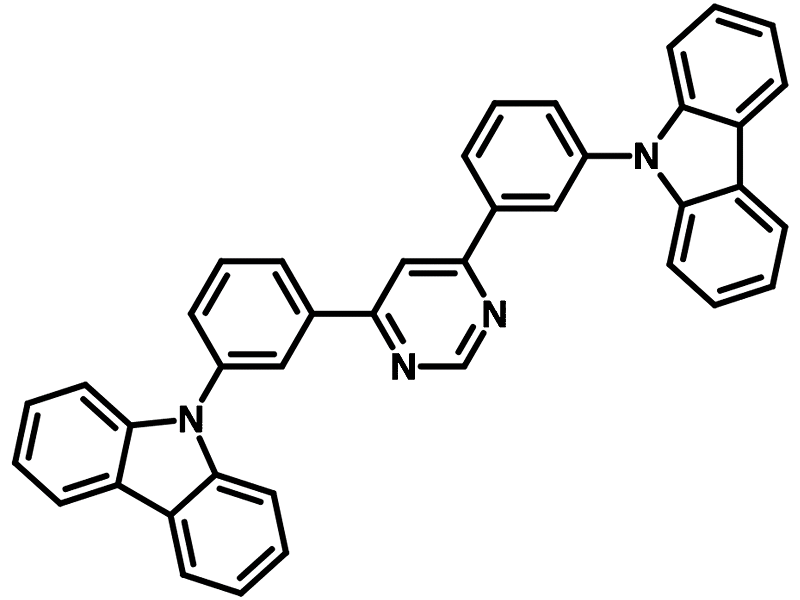46DCzPPm (CzPhPy)
CAS Number 1262678-77-2
High Purity Sublimed Materials, Host Materials, Materials, OLED Materials, Semiconducting Molecules, TADF Host Materials,46DCzPPm, bipolar host or hole blocking material
High purity (>99% sublimed) 46DCzPPm, 4,6-Bis(3-(9H-carbazol-9-yl)phenyl)pyrimidine, CzPhPy, 9Cz46Pm, 1262678-77-2
Like 26DCzPPy, 46DCzPPm (also know as CzPhPy) has a bipolar structure with two electron rich end carbazole units attached to an electron deficient biphenylpyrimidine center unit. It has one extra nitrogen unit than 26DCzPPy.
46DCzPPm is normally used as bipolar host material for blue, red and green phosphorescent OLED devices. An extremely low driving voltage of 3.9 V was achieved using 46DCzPPm as the bipolar host material, and FIrPic as the blue triplet emitter. In the device, an n-doping electron-transport layer consisting of Cs2CO3-doped 46DCzPPm and a p-doping hole-transport layer consisting of MoO3-doped 46DCzPPm were constructed [2].
With a deep HOMO energy level (6.19 eV), 46DCzPPm can also be employed as an efficient hole blocking layer material.
General Information
| CAS number | 1262678-77-2 |
|---|---|
| Chemical formula | C40H26N4 |
| Molecular weight | 562.68 g/mol |
| Absorption | λmax 292 nm (in DCM) |
| Fluorescence | λem 476 nm (in DCM) |
| HOMO/LUMO | HOMO = 6.19 eV, LUMO = 3.06 eV; ET = 2.64 eV [1] |
| Full name | 4,6-Bis(3-(9H-carbazol-9-yl)phenyl)pyrimidine |
| Synonyms | CzPhPy, 9Cz46Pm |
| Classification / Family | Carbazole derivatives, Host materials, PHOLED host materials, Hole-blocking layer, Sublimed materials, OLEDs, Organic electronics |
Product Details
| Purity | Sublimed* >99.0% |
|---|---|
| Melting point | Tm = 175 °C (Tg = 107 °C, Td = 466 °C) |
| Colour | White Powder |
Sublimation is a technique used to obtain ultra pure-grade chemicals. For more details about sublimation, please refer to the sublimed materials for OLED devices page.
Chemical Structure

Device Structure(s)
| Device structure | ITO/HATCN (5 nm)/NPB (30 nm)/TCTA (10 nm)/mCPBC:30 wt% 33PCX:1 wt% v-DABNA (30 nm)/46DCzPPm (10 nm)/DPyPA:Liq (1:1, 30 nm)/LiF (0.5 nm)/Al (150 nm) [2] |
|---|---|
| Colour |
|
| Max. EQE | 27.5% |
| Max. Power Efficiency | 39.7 lm W−1 |
| Device structure | ITO/HATCN (5 nm)/NPB (30 nm)/TCTA (10 nm)/mCPBC:30 wt% 23PCX:1 wt% v-DABNA (30 nm)/46DCzPPm (10 nm)/DPyPA:Liq (1:1, 30 nm)/LiF (0.5 nm)/Al (150 nm) [2] |
|---|---|
| Colour |
|
| Max. EQE | 25.2% |
| Max. Power Efficiency | 53.5 lm W−1 |
Pricing
| Grade | Order Code | Quantity | Price |
|---|---|---|---|
| Sublimed (>99%) | M2354A1 | 250 mg | £360 |
| Sublimed (>99%) | M2354A1 | 500 mg | £580 |
| Sublimed (>99%) | M2354A1 | 1 g | £950 |
MSDS Documentation
Literature and Reviews
- Highly Efficient and Stable Blue Organic Light-Emitting Diodes based on Thermally Activated Delayed Fluorophor with Donor-Void-Acceptor Motif, D. Zhang et al., Adv. Sci., 9, 2106018 (2022); DOI: 10.1002/advs.202106018.
- Efficient Low-Driving-Voltage Blue Phosphorescent Homojunction Organic Light-Emitting Devices, C. Cai et al., Jpn. J. Appl. Phys. 50, 040204 (2011); DOI:10.1143/jjap.50.040204.
- RGB Phosphorescent Organic Light-Emitting Diodes by Using Host Materials with Heterocyclic Cores: Effect of Nitrogen Atom Orientations, S. Su et al., Chem. Mater., 23, 2, 274–284 (2011); DOI: 10.1021/cm102975d.

 46DCzPPm MSDS sheet
46DCzPPm MSDS sheet